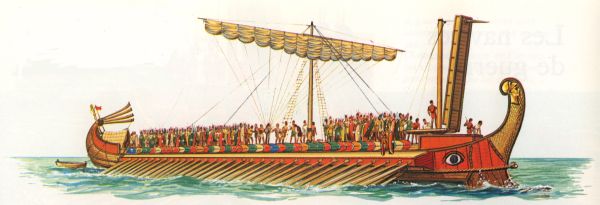
The quinquereme was about 40 - 45 meters long, 4 meters wide (excluding gunwhale), with a draft of around 1.5 meters.
It displaced about 60 - 100 tons and had a crew of 300 rowers, 20 - 30 sailors and 40 - 120 marines.
It had one deck that spanned almost the entire length of the ship.
A well-equipped shipyard could build a quinquereme in 1½ - 2 months.
The large number of people on board made them costly, but quinquiremes were faster and more seaworthy than triremes and had enough room for a large compliment of marines.
They seem to have been at the top of the balance between agility and power for ancient galleys.
These ships were equipped with rams, but Romans and Carthaginians used boarding tactics equally often.
Early Roman quinqueremes were equipped with a "corvus", a boarding bridge that could be hauled up and dropped onto the deck of an emey ship,
securing itself with a heavy spike at the end.
The corvus was a good boarding tool, but made the ship top-heavy.
It was later replaced by the "harpago", a catapult that fired a harpoon-like grappling hook.
The first quinquereme was built by Dionysus of Syracuse in 339 BCE, though this seems to have been no more than an early prototype.
They design was quickly adopted by Greek and Phoenician shipbuilders and the quinquereme became the standard warship in the Mediterranean in the last three centuries BCE.
It was used extensively by the Carthaginians and Romans during the Punic wars.
During the time of the emperors all large rival navies were vanquished, so quinqueremes became rare and more attention was given to smaller and lighter ships.
War Matrix - Quinquereme
Persian Era 550 BCE - 330 CE, Weapons and technology


